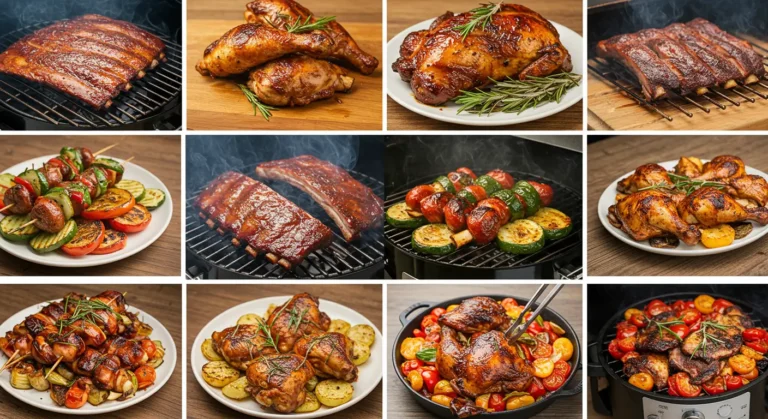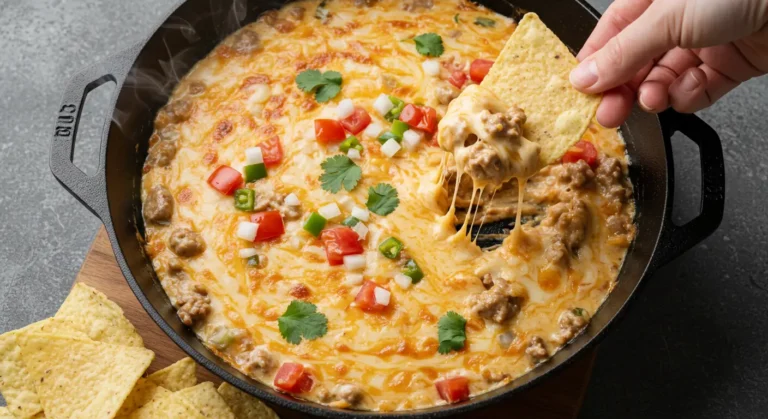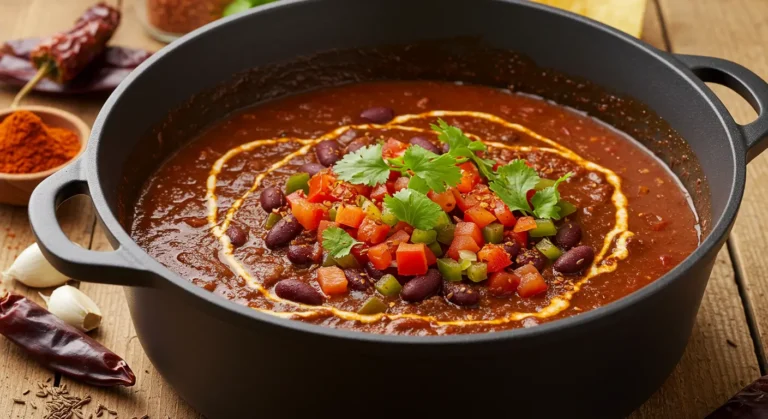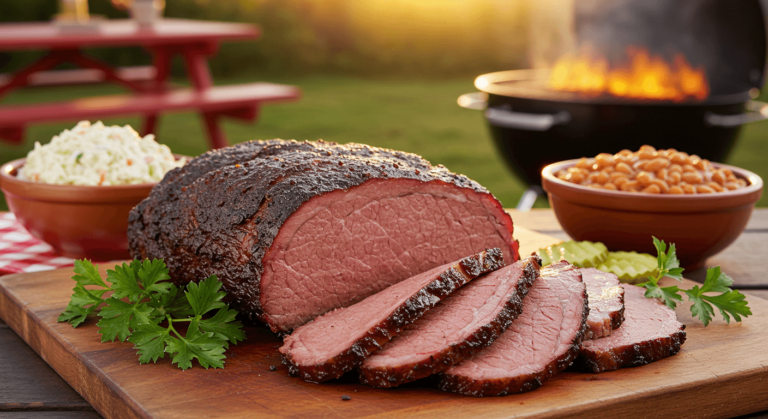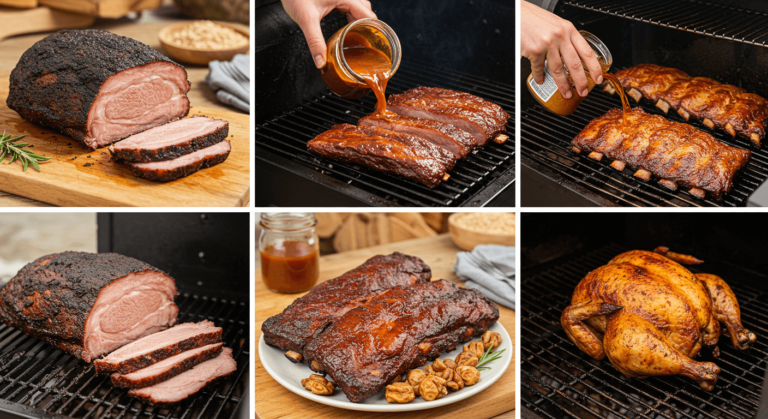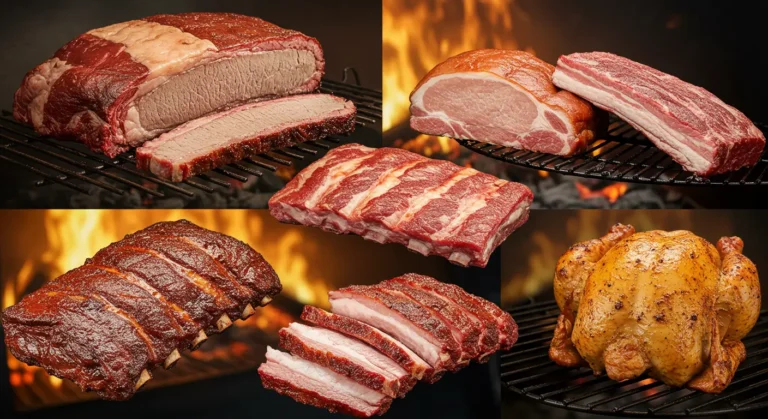Good Meats to Smoke for Beginners
There’s something almost magical about that first moment when you lift the lid of your smoker. A cloud of aromatic smoke escapes, carrying with it the promise of flavors developing slowly over hours of patient cooking. The gentle sizzle of fat rendering, the gradually deepening color of the meat, and the mouthwatering scent that draws neighbors from blocks away – these are the sensory rewards that make smoking food one of the most satisfying cooking methods you’ll ever master.
Whether you’ve just purchased your first smoker or you’re looking to expand your repertoire beyond basic backyard grilling, this guide will walk you through everything you need to know about selecting good meats to smoke. I’ve spent countless weekends perfecting these techniques, experiencing both triumphant successes and humbling failures, and I’m excited to share what I’ve learned with you on this flavorful journey.
What Makes Smoking Different from Other Cooking Methods?
Smoking stands apart from other cooking techniques through its unique combination of low temperatures, extended cooking times, and the infusion of wood smoke flavors. Unlike the intense heat of grilling that quickly sears meats, smoking gently breaks down tough connective tissues and fats over many hours, resulting in unparalleled tenderness and depth of flavor.
As award-winning pitmaster Aaron Franklin says, “Smoking isn’t just cooking with smoke—it’s an exercise in patience and understanding how heat, time, and smoke interact with food.”
best good meats to smoke
In this comprehensive guide, we’ll explore:
- The fundamentals of smoking meat
- Different types of smokers and their advantages
- The best meats for beginners to smoke
- Essential techniques for smoking success
- Beginner-friendly recipes to build your confidence
- Advanced options for when you’re ready for a challenge
- Creative alternatives beyond traditional meats
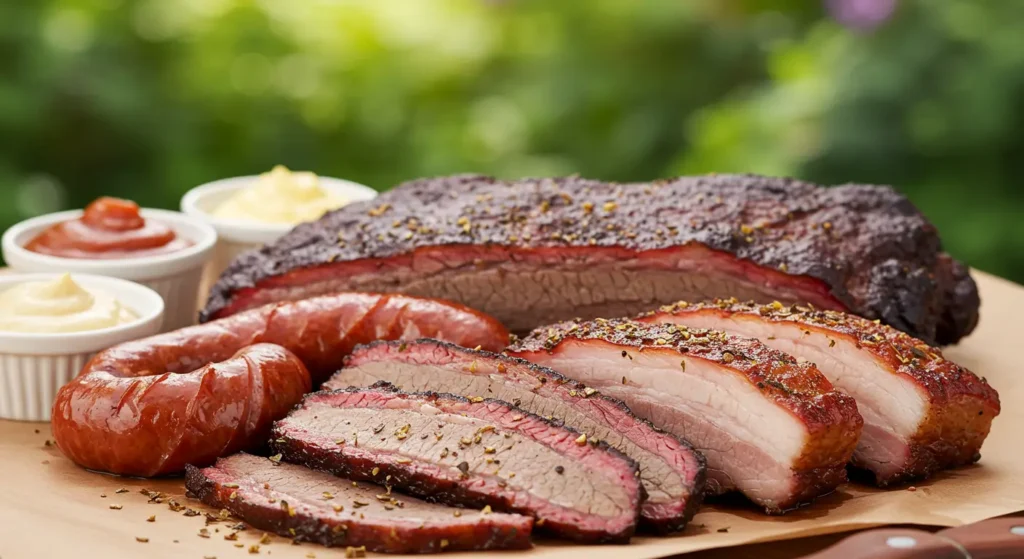
The Art and Science of Smoking Food
How Does Smoking Work?
At its core, smoking is about the slow transformation of food through gentle heat and wood smoke. When you maintain temperatures between 225-275°F, several magical things happen:
- Tough collagen in meat converts to gelatin, creating that melt-in-your-mouth texture
- Fat renders slowly, basting the meat from within
- The exterior develops a flavorful bark or crust
- Smoke particles adhere to the surface, creating complex flavor compounds
- Moisture is retained while unwanted fat melts away
- good meats to smoke
Wood Types and Flavor Profiles
The wood you choose significantly impacts your final flavor. Here’s a quick guide to making smart pairings:
- Hickory: Strong and bacon-like; excellent for beef and chicken
- Apple: Mild and slightly sweet; perfect for poultry and fish
- Mesquite: Intensely earthy and strong; use sparingly with beef
- Cherry: Mild with slight sweetness; creates beautiful color and works with most meats
- Oak: Medium strength and versatile; the “all-purpose” smoking wood
- Maple: Mild and subtly sweet; excellent for poultry and vegetables
“The right wood choice is like selecting the perfect spice,” says BBQ champion Myron Mixon. “It should complement your meat, not overpower it.”
Understanding Temperature Control
Maintaining consistent temperature is perhaps the most crucial smoking skill. Too hot, and your meat will dry out; too cool, and it may never become tender. Most successful smokes maintain a steady 225-250°F throughout the cooking process.
Many beginners panic when they encounter “the stall”—that frustrating period when your meat’s internal temperature seems stuck for hours, typically around 150-170°F. This happens because moisture evaporating from the surface cools the meat, counteracting the heat from your smoker. Be patient; this is normal and will eventually pass.

What Types of Smokers Work Best for Beginners?
Electric Smokers
Advantages: Set-and-forget temperature control, minimal learning curve Best for: Busy people who want consistency without constant monitoring Limitations: Less intense smoke flavor than traditional smokers
Pellet Smokers
Advantages: Automated feed system, consistent temperatures, versatile cooking styles Best for: Those wanting convenience without sacrificing authentic flavor Limitations: Requires electricity, less “hands-on” experience
Kettle Grills
Advantages: Affordable if you already own one, great for learning fire management Best for: Beginners who want to try smoking without investing in new equipment Limitations: More challenging to maintain consistent temperatures
Offset Smokers
Advantages: Traditional approach, exceptional flavor development, great capacity Best for: Enthusiasts who enjoy the process as much as the result Limitations: Steeper learning curve, requires more attention
Ceramic Kamado Smokers
Advantages: Excellent insulation, temperature stability, fuel efficiency Best for: Those seeking versatility (they grill, smoke, and bake) Limitations: Higher initial investment, heavier
What Are the Best Meats for Smoking When You’re Just Starting Out?
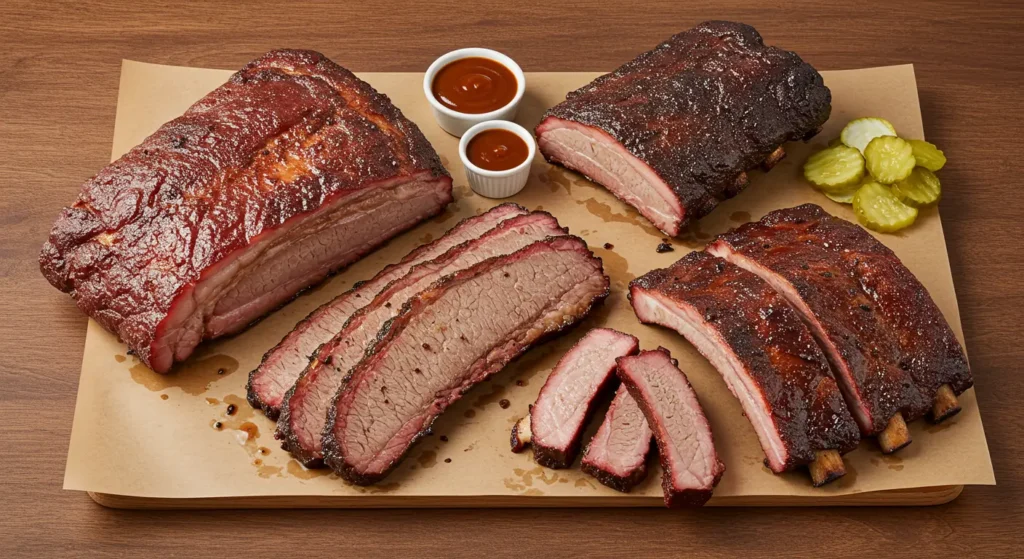
Chicken: The Confidence Builder
Chicken earns its place as a beginner’s smoking project for several compelling reasons. With relatively short cooking times (2-4 hours), you’ll get quicker feedback on your technique without committing an entire day. Whole chickens are inexpensive, making them perfect practice material as you learn to manage your smoker’s temperature.
For best results:
- Choose a 4-5 pound bird
- Brine it overnight (1/4 cup salt, 1/4 cup sugar, 1 gallon water)
- Pat dry before applying rub
- Smoke at 275°F until breast reaches 165°F
- Use mild woods like apple or cherry
Pro tip: Spatchcock your chicken (remove the backbone and flatten) to reduce cooking time and ensure more even cooking.
Turkey Breast: Forgiving and Flavorful
Turkey breast offers an excellent entry point to smoking techniques. Its larger size compared to chicken parts means it’s more forgiving of temperature fluctuations, yet it doesn’t require the marathon smoking sessions of larger cuts.
For best results:
- Select a 5-7 pound bone-in breast
- Brine for 12-24 hours before smoking
- Apply a light coating of oil and your favorite rub
- Smoke at 250°F until internal temperature reaches 165°F (about 3-4 hours)
- Let rest 20-30 minutes before slicing
Pro tip: Place a pan of apple juice under the turkey during smoking to add moisture and create a subtle flavor enhancement.
Beef Chuck Roast: Brisket’s More Forgiving Cousin
While brisket gets all the glory in smoking circles, the humble chuck roast offers similar rich beef flavor with less financial risk and time commitment. This cut contains beautiful marbling that renders during the smoking process, creating a final product reminiscent of brisket but more forgiving for newcomers.
For best results:
- Choose a 4-5 pound chuck roast with good marbling
- Apply a simple rub of salt, pepper, and garlic powder
- Smoke at 250°F until it reaches an internal temperature of 200-205°F (about 5-6 hours)
- Wrap in butcher paper when it hits 165°F to push through the stall
- Rest for at least 30 minutes before pulling or slicing
Pro tip: Don’t rush the final temperature goal. The magic happens between 195°F and 205°F when collagen fully converts to gelatin.
Sausage: Quick Gratification
For those seeking almost immediate smoking gratification, sausages provide excellent results with minimal time investment. Store-bought sausages allow you to focus on mastering temperature control without worrying about meat preparation.
For best results:
- Choose high-quality sausages with some fat content
- Smoke at 225-250°F until they reach 160°F internally (usually 1-2 hours)
- Consider a light glaze of maple syrup in the last 20 minutes for a sweet finish
- Use mild woods like apple or cherry to complement without overwhelming
Pro tip: The “bend test” helps determine doneness—properly smoked sausages should bend without breaking while maintaining structural integrity.
What About More Traditional BBQ Cuts?
Beef Ribs: Impressive Results with Simple Technique
Beef ribs create a dramatic presentation and deliver incredible flavor while being surprisingly straightforward to prepare. Their substantial fat content makes them more forgiving than leaner cuts.
For best results:
- Look for plate ribs (also called dinosaur ribs)
- Season liberally with kosher salt and coarse black pepper
- Smoke at 250°F until probe-tender (typically 6-8 hours)
- Spritz occasionally with apple cider vinegar or apple juice
- Use oak or hickory wood for classic Texas-style flavor
Pro tip: Unlike other cuts, beef ribs benefit from being cooked directly from the refrigerator. Their size and fat content mean cold-starting helps with smoke absorption.
Beef Tri-Tip: The Weeknight Smoker Project
Tri-tip offers rich beef flavor in a package that cooks relatively quickly (1-2 hours), making it perfect for weeknight smoking when you don’t have all day to tend a fire.
For best results:
- Look for well-marbled, 2-3 pound tri-tips
- Season simply with salt, pepper, and garlic
- Smoke at 225°F until internal temperature reaches 130-135°F for medium-rare
- Rest for 15 minutes before slicing against the grain
- Oak or hickory provide complementary flavors
Pro tip: Tri-tip has grain directions that change midway through the cut. Make sure to identify this change and adjust your slicing accordingly.
How Do I Smoke Seafood Successfully?
For smoking novices looking to branch beyond land animals, firm fish like salmon and trout offer excellent starting points. Their natural oils help prevent drying out during the smoking process.
Smoked Salmon: A Weekend Project
For best results:
- Choose fresh, high-quality salmon fillets with skin on
- Cure overnight with a mixture of salt, brown sugar, and dill
- Rinse and let form a pellicle (sticky surface) for 1-2 hours before smoking
- Smoke at a lower temperature (160-180°F) until it reaches 145°F internal temperature
- Use alder or apple wood for complementary flavor
Pro tip: The formation of the pellicle—that slightly tacky surface that develops after curing—is crucial for smoke adhesion and texture. Don’t skip this step.
Beyond Meat: What Else Can I Smoke?
Vegetables That Shine in the Smoker
Smoking transforms ordinary vegetables into extraordinary sides:
- Bell Peppers: Smoke halved peppers for 1 hour at 225°F for smoky-sweet flavor
- Corn on the Cob: Leave in husks and smoke for 45-60 minutes at 250°F
- Onions: Halve them, add butter and herbs, and smoke for 1-2 hours
- Mushrooms: Portobellos absorb smoke beautifully; 30-45 minutes is usually sufficient
Unexpected Smoking Stars
Think beyond typical smoking candidates:
- Nuts: Smoke almonds, pecans, or walnuts at 225°F for 45 minutes for amazing snacks
- Salt: Place a thin layer of kosher salt in a foil pan and smoke for 4 hours to create a finishing salt that adds smoky flavor to any dish
- Butter: Smoke cold sticks of butter at 175°F for 30 minutes for an incredible compound butter
- Cheese: Cold-smoke blocks of cheese like cheddar or gouda at temperatures below 90°F for 2-4 hours
Common Smoking Mistakes and How to Avoid Them
Temperature Fluctuations
The problem: Wild temperature swings can lead to uneven cooking and unpredictable results. The solution: Make small, incremental adjustments to your vents. Remember that smoking is mostly about oxygen control, not adding more fuel.
Too Much Smoke
The problem: Billowing white smoke creates bitter, acrid flavors. The solution: Aim for thin, blue smoke that’s barely visible. This indicates clean combustion and creates the best flavor.
Checking Too Often
The problem: Every time you open your smoker, you lose heat and extend cooking time. The solution: “If you’re looking, you’re not cooking.” Trust your temperature probes and resist the urge to peek.
Not Allowing Enough Time
The problem: Rushing the process or not planning for the “stall.” The solution: Always add 2 hours to your estimated cooking time as a buffer. Smoked foods hold well when wrapped in towels and placed in a cooler.
Beginner-Friendly Recipe: Smoked Turkey Breast
Ingredients:
- 1 bone-in turkey breast (5-7 pounds)
- 2 tablespoons olive oil
- 3 tablespoons poultry rub (store-bought or homemade)
For the brine:
- 1 gallon water
- 3/4 cup kosher salt
- 1/2 cup brown sugar
- 3 bay leaves
- 1 tablespoon peppercorns
Instructions:
- Combine brine ingredients in a large container and stir until salt and sugar dissolve
- Submerge turkey breast and refrigerate for 12-24 hours
- Remove from brine, rinse thoroughly, and pat dry
- Let sit uncovered in refrigerator for 2 hours to form a pellicle
- Rub with olive oil and apply seasoning liberally
- Preheat smoker to 250°F using apple wood
- Smoke until internal temperature reaches 165°F (approximately 3-4 hours)
- Rest for 20-30 minutes before slicing
- Serve with your favorite sides
Advanced Recipe: Smoked Lamb Shoulder
For those ready to venture beyond the basics, lamb shoulder offers rich flavor and wonderful texture when smoked properly.
Ingredients:
- 5-6 pound bone-in lamb shoulder
- 1/4 cup olive oil
- 6 cloves garlic, minced
- 2 tablespoons fresh rosemary, chopped
- 2 tablespoons fresh thyme, chopped
- 2 tablespoons kosher salt
- 1 tablespoon black pepper
- 1 tablespoon paprika
- 1 teaspoon cumin
Instructions:
- Combine all seasonings with olive oil to create a paste
- Thoroughly coat lamb shoulder with the paste, working it into crevices
- Wrap tightly and refrigerate overnight
- Bring to room temperature for 1 hour before smoking
- Preheat smoker to 250°F using oak or cherry wood
- Smoke until internal temperature reaches 190-195°F (approximately 7-8 hours)
- Wrap in butcher paper when it reaches 165°F internal temperature
- Rest wrapped in towels and placed in a cooler for 1 hour before pulling
- Serve with mint yogurt sauce and flatbreads
Frequently Asked Questions
Conclusion
Smoking meat is both a science and an art form—a beautiful balance of technical knowledge and creative intuition. As you begin your smoking journey, remember that even “failures” are often delicious learning experiences. Start with forgiving cuts like chicken and turkey breast, then gradually work your way up to more challenging projects.
The smoking community is incredibly supportive and always ready to share advice. Connect with fellow enthusiasts online, at competitions, or simply by inviting friends over to enjoy your creations. There’s something deeply satisfying about sharing food you’ve patiently crafted over many hours of attentive cooking.
Most importantly, develop your own style. While there are fundamental techniques worth mastering, the joy of smoking comes from putting your personal stamp on the process. Experiment with different woods, rubs, and techniques until you discover your signature approach. Best Meats to Smoke
Your smoking journey is just beginning—enjoy every delicious step of the way!
Have You Tried This Recipes!
There are no reviews yet. Be the first one to write one.


